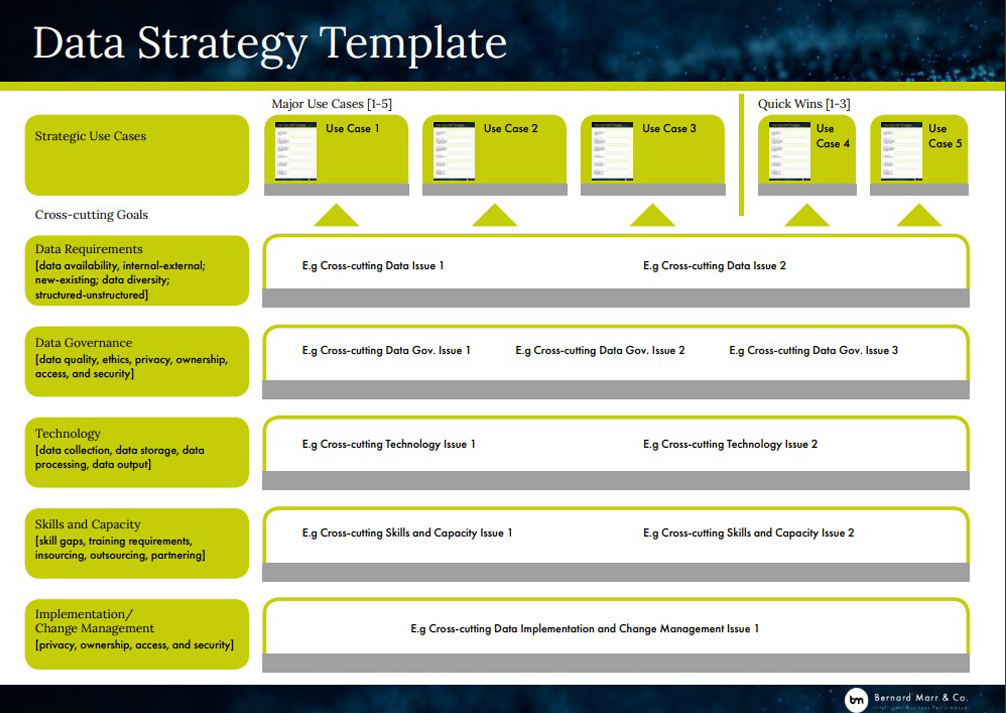How To Develop A Data Strategy – With Handy Template
2 July 2021
In a previous article, I looked at data use cases – or working out how you want to use data in your business.
Once you know how you want to use data, your next task is to turn that into a data strategy. This article – and the accompanying Data Strategy Template (see figure below) – is designed to help you cement your data priorities, and identify cross-cutting issues, themes, requirements and goals … all on one handy page.

It’s a good idea to have the Data Strategy Template open
[Download it from here]
while you read this article, as I’ll refer to it throughout.
Start with your data use cases
If you haven’t done so already, you’ll need to fill out the Data Use Case Template for each of your planned data projects. That process will help you prioritise your data projects and identify which ones you want to include in your data strategy.
Data use cases are different for every company, and will be driven by your strategic goals. Examples of data use cases/data projects include:
- Identifying new, smarter products or services
- Automating manufacturing processes to make them more efficient
- Delivering a more personalised customer experience
- Optimising prices
Now, if you turn to the Data Strategy Template, you’ll see that your data uses come right at the very top. Therefore, this is where you identify your top three data priorities for the year ahead. I find it’s also helpful to include a couple of ‘quick win’ data uses – demonstrating value from data in relatively quick, easy ways.
The rest of the Data Strategy Template is broken down into different requirements, such as what data you’ll need and what technology you’ll need to invest in, and the idea is to identify cross-cutting challenges, themes, activities, issues and goals across these areas.
We do this because, even though each use case/data project is different, they’ll ultimately share some of the same issues or challenges. Identifying these common themes at this early stage will help you to find the most effective and efficient ways to overcome them.
So, working through the rest of the template, you’ll then look at the following areas:
Data requirements
In very simple terms, your data requirements boil down to: what data are you going to need and how will you source that data? Therefore, this is your opportunity to identify the common themes, issues and so on that are related to the data itself.
For example, a common theme across your data use cases might be data diversity. In other words, how will you combine different data (internal and external, structured and unstructured, etc.) to ensure you’re getting as rich and full a picture as possible?
Data governance
This is a broad area, encompassing data quality, ethics, privacy, ownership, access and security. As such, there are bound to be cross-cutting data governance issues that are the same across your different use cases.
As an example, maybe you identify here that data quality is an issue across the whole organisation. That means, before you can achieve your data priorities, you’ll need to make sure that all data is accurate, complete and up to date – and put in place various processes to ensure it stays that way.
Technology
Here, you want to identify cross-cutting issues that relate to technology and infrastructure. Or, to put it another way, are there any software and hardware requirements that are common across your use cases?
For this, it helps to consider the four layers of data and pinpoint what technology is required for each stage:
- Collecting data
- Storing data
- Processing (analysing) data
- Communicating insights from data
For example, let’s say two of your use cases will ultimately involve surveying customers at various stages of the customer journey (e.g. after they’ve contacted the customer service team, or after they’ve bought a product). Do you already have software that can capture, store and interrogate that data to gather insights? Or will you have to invest in new software?
Skills and capacity
Lack of data knowledge and skills is a big concern for many companies, so you’re likely to have a number of cross-cutting requirements around closing the skills gap, training staff, outsourcing data collection and analysis where appropriate, or partnering with a data provider.
If your plan is to work with an external data provider, one cross-cutting issue may be the need to transfer knowledge from that external partner back into the company.
Implementation/change management
Here you should identify any common issues or requirements that might prevent you from turning your plan into reality. What challenges will you need to overcome in the implementation of your data strategy?
As an example, let’s say there’s a fundamental issue with data buy-in across your business. Therefore, a cross-cutting requirement may be to invest time in educating managers and teams on the benefits of data, and the need to base decisions on data, not assumptions.
Where to go from here
This one-page Data Strategy Template will help you identify common themes and issues across your data priorities, and serve as a visual reminder of what you’re trying to achieve.
However, a one-pager is never going to be detailed enough to explore all of the issues, challenges and requirements for data sources, data governance, technology, skills and implementation. For that, it’s likely you’ll need a more detailed, narrative document.
Over the years, I’ve helped companies big and small identify their data priorities and create a data strategy. So if you’d like help with your data strategy, get in touch.
You may also like to check out my articles on:
Related Articles
The 8 Data Trends That Will Define 2026
By now, “smart” versions exist of just about every home appliance, gadget and gizmos we can think of. However, manufacturers continue[...]
7 Quantum Computing Trends That Will Shape Every Industry In 2026
By now, “smart” versions exist of just about every home appliance, gadget and gizmos we can think of. However, manufacturers continue[...]
5 Business Trends Every Company Must Prepare for in 2026
By now, “smart” versions exist of just about every home appliance, gadget and gizmos we can think of. However, manufacturers continue[...]
The Quantum Revolution Is Here, And It’s About More Than Just Computing
By now, “smart” versions exist of just about every home appliance, gadget and gizmos we can think of. However, manufacturers continue[...]
6 Critical Telecom Trends In 2026: What Industry Leaders Need To Know
By now, “smart” versions exist of just about every home appliance, gadget and gizmos we can think of. However, manufacturers continue[...]
Technology in Action: My Key Takeaways on How AI and Quantum Are Accelerating Global Transformation
By now, “smart” versions exist of just about every home appliance, gadget and gizmos we can think of. However, manufacturers continue[...]
Sign up to Stay in Touch!
Bernard Marr is a world-renowned futurist, influencer and thought leader in the fields of business and technology, with a passion for using technology for the good of humanity.
He is a best-selling author of over 20 books, writes a regular column for Forbes and advises and coaches many of the world’s best-known organisations.
He has a combined following of 4 million people across his social media channels and newsletters and was ranked by LinkedIn as one of the top 5 business influencers in the world.
Bernard’s latest book is ‘Generative AI in Practice’.










Social Media